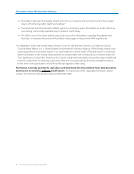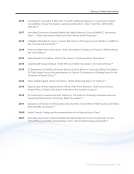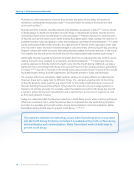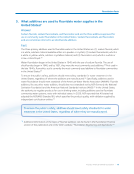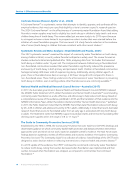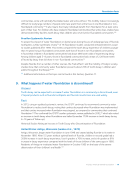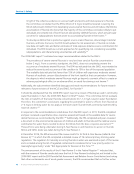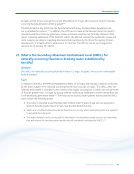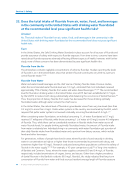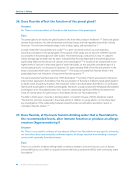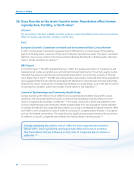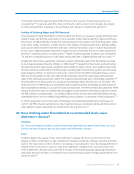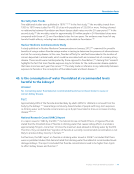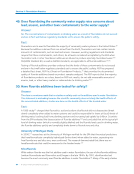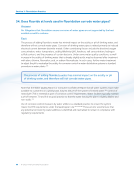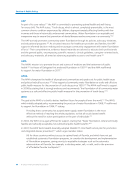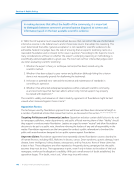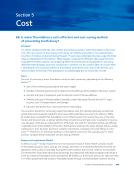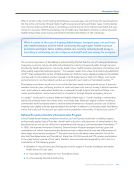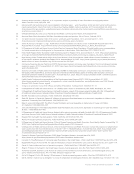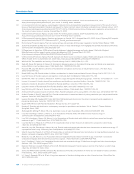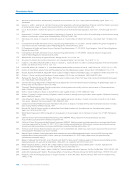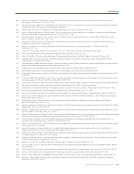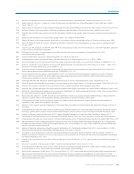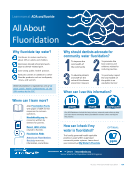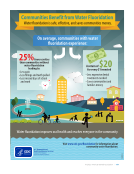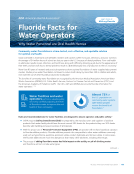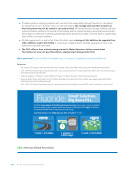34 l © 2025 American Dental Association
Section 1: Effectiveness and Benefits
FDA Bottled Water Standards
Noting that fluoride can occur naturally in source waters used for bottled water or can be added by
a bottled water manufacturer, the FDA has approved standards for the fluoride content of bottled
water.166 However, the FDA regulations require the fluoride content of bottled water to be listed on the
label only if fluoride is added during processing.167 If the fluoride level is not shown on the label of the
bottled water, the company can be contacted, or the water can be tested to obtain this information.
Most consumers are unaware that the vast majority of bottled waters, including all products treated
by distillation or reverse osmosis, are largely fluoride-free. Unknowingly, individuals who drink bottled
water as their primary source of water could be missing the decay-preventive effects of optimally
fluoridated water available from their community water supplies. The ADA supports the labeling of
the fluoride content of bottled water to aid consumers in making informed decisions about choices
of drinking water.168
Recognizing the benefit of fluoride in drinking water, in 2006 the FDA issued the “FDA Health Claim
Notification for Fluoridated Water and Reduced Risk of Dental Caries,”169 which states that bottled
water meeting the specific standards of identity and quality set forth by the FDA, and containing
between 0.6–1.0 mg/L total fluoride, can be labeled with the following health claim: “Drinking
fluoridated water may reduce the risk of [dental caries or tooth decay].” This health claim is not
intended for use on bottled water products specifically marketed for use by infants.169
Additional information on this topic can be found in the Safety Section, Question 28.
Prevalence of Bottled Water in the United States
According to a 2017 press release from the Beverage Marketing Corporation,170 bottled water
surpassed carbonated soft drinks in 2016 to become the largest beverage category by volume in
the United States. Per capita consumption of bottled water was approximately 39.3 gallons in 2016,
while the average consumption of carbonated soft drinks was approximately 38.5 gallons per person
per year. The per capita consumption of bottled water continues to grow, reaching roughly 46.5
gallons in 2022.171 Single-serve bottled water accounted for the majority (71%) of US bottled water
volume sales.171
Individuals choose to drink bottled water for various reasons. Some find it a calorie-free substitute for
carbonated soft drinks or other sugary beverages. Others dislike the taste of their tap water or have
concerns about the possible contaminants in their local water supply.
A small study172 of a convenience sample of caretakers and adolescents at an urban clinic published
in 2012 found that 17% drank tap water exclusively, 38% drank bottled water exclusively, and 42%
drank both. Bottled water was ranked significantly higher in taste, clarity, purity, and safety than tap
water. Only 24% of caretakers of children and adolescents knew if fluoride was in their drinking water.
The authors concluded that perceptions of the qualities of water were most responsible for choices
of drinking water.172 Similar findings have been found in earlier studies.173–175 Additionally, cultural
influences can affect drinking water preferences. In some Latino communities, parents were less likely
to give tap water to their children because they believed tap water would make them sick. This often
is based largely on the fact that many have come to the United States from places with poor water
quality where water-borne illness was common.175 Besides missing the decay-preventive effects of
fluoridated tap water, families spend hundreds of dollars more each year on purchasing water than if
they were to consume tap water.173,175
Section 1: Effectiveness and Benefits
FDA Bottled Water Standards
Noting that fluoride can occur naturally in source waters used for bottled water or can be added by
a bottled water manufacturer, the FDA has approved standards for the fluoride content of bottled
water.166 However, the FDA regulations require the fluoride content of bottled water to be listed on the
label only if fluoride is added during processing.167 If the fluoride level is not shown on the label of the
bottled water, the company can be contacted, or the water can be tested to obtain this information.
Most consumers are unaware that the vast majority of bottled waters, including all products treated
by distillation or reverse osmosis, are largely fluoride-free. Unknowingly, individuals who drink bottled
water as their primary source of water could be missing the decay-preventive effects of optimally
fluoridated water available from their community water supplies. The ADA supports the labeling of
the fluoride content of bottled water to aid consumers in making informed decisions about choices
of drinking water.168
Recognizing the benefit of fluoride in drinking water, in 2006 the FDA issued the “FDA Health Claim
Notification for Fluoridated Water and Reduced Risk of Dental Caries,”169 which states that bottled
water meeting the specific standards of identity and quality set forth by the FDA, and containing
between 0.6–1.0 mg/L total fluoride, can be labeled with the following health claim: “Drinking
fluoridated water may reduce the risk of [dental caries or tooth decay].” This health claim is not
intended for use on bottled water products specifically marketed for use by infants.169
Additional information on this topic can be found in the Safety Section, Question 28.
Prevalence of Bottled Water in the United States
According to a 2017 press release from the Beverage Marketing Corporation,170 bottled water
surpassed carbonated soft drinks in 2016 to become the largest beverage category by volume in
the United States. Per capita consumption of bottled water was approximately 39.3 gallons in 2016,
while the average consumption of carbonated soft drinks was approximately 38.5 gallons per person
per year. The per capita consumption of bottled water continues to grow, reaching roughly 46.5
gallons in 2022.171 Single-serve bottled water accounted for the majority (71%) of US bottled water
volume sales.171
Individuals choose to drink bottled water for various reasons. Some find it a calorie-free substitute for
carbonated soft drinks or other sugary beverages. Others dislike the taste of their tap water or have
concerns about the possible contaminants in their local water supply.
A small study172 of a convenience sample of caretakers and adolescents at an urban clinic published
in 2012 found that 17% drank tap water exclusively, 38% drank bottled water exclusively, and 42%
drank both. Bottled water was ranked significantly higher in taste, clarity, purity, and safety than tap
water. Only 24% of caretakers of children and adolescents knew if fluoride was in their drinking water.
The authors concluded that perceptions of the qualities of water were most responsible for choices
of drinking water.172 Similar findings have been found in earlier studies.173–175 Additionally, cultural
influences can affect drinking water preferences. In some Latino communities, parents were less likely
to give tap water to their children because they believed tap water would make them sick. This often
is based largely on the fact that many have come to the United States from places with poor water
quality where water-borne illness was common.175 Besides missing the decay-preventive effects of
fluoridated tap water, families spend hundreds of dollars more each year on purchasing water than if
they were to consume tap water.173,175










